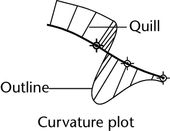Curvature is a measure of how much a curve curves.

Curvature is measured by fitting a circle into the curve, then taking the reciprocal of the circle’s radius. In this figure, at point x the curve is best described by a circle with radius r. At this point, the curvature is 1/r.
(We use the reciprocal, 1/r, instead of just r because a flat line has an infinite radius. Taking the reciprocal gives us 0 instead of infinity.)

Continuity for NURBS curves and surfaces
Continuity is a measure of how smoothly two curves or surfaces “flow” into each other at their meeting point. The type of curvature your curves and surfaces have may be important if you need to subsequently export your Maya NURBS surfaces to a CAD software application.

The endpoints of the two curves or surfaces meet exactly. Note that the two curves or surfaces can meet at any angle and still have positional continuity.


Curves or surfaces that have tangent continuity also have positional continuity, plus the end tangents match at the common endpoint. The two curves will appear to be travelling in the same direction at the join, but they may still have very different apparent “speeds” (rate of change of the direction, also called curvature).

For example, in this figure, the two curves have the same tangent (the double-arrow line) at the join (the dot). But the curve to the left of the join has a slow (low) curvature at the join, while the curve to the right of the join has a fast (high) curvature at the join.